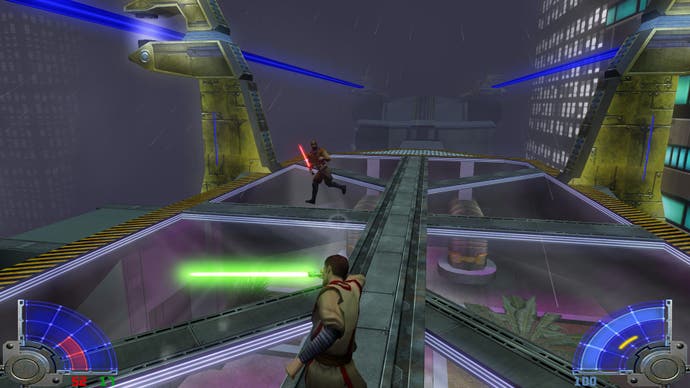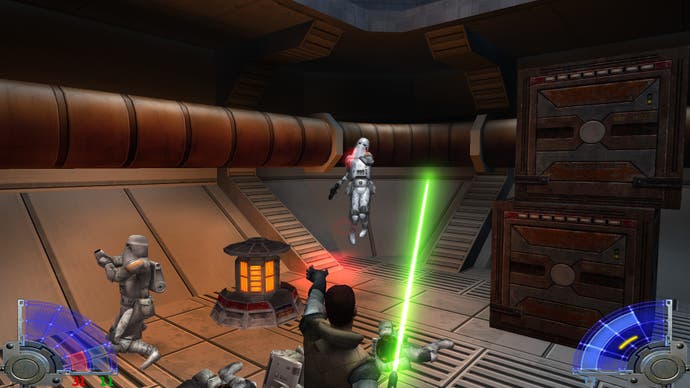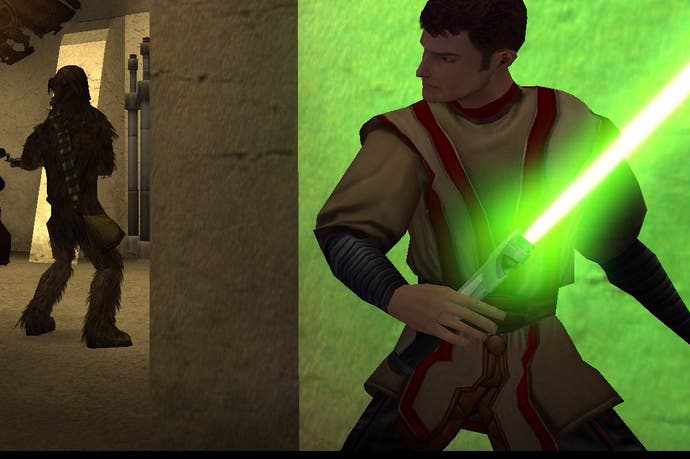Jedi Academy shows Battlefront 2 how to do lightsabers right
Most impressive.
It's fair to say that Battlefront 2 has endured a difficult time of late, much in the same way Anakin Skywalker had a difficult time after fighting Obi Wan Kenobi in Revenge of the Sith. Like poor, pathetic Ani, crawling through the mud with three missing limbs and his skin on fire, Battlefront 2 is a hot mess right now. There's a decent, upstanding multiplayer shooter somewhere in there, but it has been laid low by poorly-thought out microtransactions and subscribing to the absurd notion that Star Wars is somehow about making money. The cheek of it!
Although we know how EA's chosen one succumbed to the dark side of the farce, it's hard not to feel a teensy bit sorry for Battlefront 2. It would take an especially heartless individual to look down at this pitiful creature, once so mighty and proud, and quietly whisper "Oh and by the way, your lightsabers are shit."
On the other hand, I've never exactly claimed to be Yoda.
By Jabba's flabby folds, Battlefront 2's lightsabers are atrocious. For starters, their blades are weirdly short, which makes all the Jedi and Sith in the game look like they're gearing up to play a match of space rounders. I can only assume the designers decided to reduce the force-wielding characters' reach for the sake of balance. But when your game allows certain players to assume the role of a bona-fide space wizard, I feel like balance is something of a lost cause.

I could possibly forgive DICE for lightsabers that look like glowing sports bats, were it not for the fact that they also function the same way. Battlefront 2's lightsabers are neon truncheons, used to bludgeon stormtroopers/rebels (delete as appropriate) into submission like police at a football riot. And that's just completely wrong. A lightsaber is not a glowstick or a radioactive pool noodle, it's a blade of light that can cut through literally anything.
It's a shame as, in fact, the perfect gaming lightsaber already exists. It was created 14 years ago by Raven Software. Before the studio shuffled off to an eternity of churning out Call of Duty map-packs for Activision, Raven Software created two of the finest Star Wars games ever made, Jedi Outcast and Jedi Academy. Jedi Outcast was basically an FPS that had a surprisingly brilliant melee combat system attached to it. Jedi Academy, meanwhile, was a full-blown Jedi simulator.
Whereas Outcast took a good few hours to get to the whole "Jedi" part, Academy lets you play with space magic from its tutorial onward. You encounter your first Sith within ten minutes, and you can play the whole game without touching any of the blasters if you so choose.
In other words, Academy provides you with ample space to experiment with its delightful lightsaber combat. It's a fantastically designed system, with a broad range of attack types that are all easy to execute, and lithe animations that brilliantly convey the Jedi's force-enhanced acrobatic abilities. But what makes the combat special comes down to how the lightsabers are represented.

Crucially, Jedi Academy's lightsabers are constantly active. This means that they interact with the environment even when you're not pressing the attack button. Your lightsaber leaves a mark on anything it touches, carving glowing orange score-lines in walls, floors, objects, and even enemies. You don't even need to swing the lightsaber to kill opponents with it. You can just run into a stormtrooper with the blade extended, and his armour will begin to hiss and spark as the lightsaber's beam cuts through it like a hot knife through space-fascist.
This is obviously rather amusing, but it's also a vital component of why Jedi Academy's lightsaber battles are so entertaining. The other important design choice is that, unlike most modern combat systems, all of Jedi Academy's animations play out freely from other agents in the world. Most modern melee combat games, like Assassin's Creed or Arkham Asylum, use combat animations that often lock characters together, because they look flashier in trailers and promoted YouTube Let's Plays. But such animation also removes the natural chaos of hand-to-hand combat.
By comparison, Jedi Academy's battles amount to two magical acrobats jumping around, trying to stab each other with laser-swords. This means every single battle plays out in an entirely different way. Some fights may end with the first blow struck, others will be titanic encounters with both particpants backflipping around the entire map, flinging their lightsabers at each other, locking blades, and pushing and pulling one another with their force abilities. Sometimes you'll kill an opponent with a cool-looking move, other times your lightsaber might just catch their foot as they attempt to leap over your head, leaving them literally without a leg to stand on.
There's something wonderfully organic about Jedi Academy's lightsaber fights. It's a holistic, fully dynamic system, rather than being a secret rhythm action game where the punches form the beats. This isn't to say that it's complete chaos. There's subtle direction at work across the game as a whole, mainly in how the Sith you encounter become both more numerous and more challenging as the game progresses.

The saber-wielding opponents you encounter in the first half of the game are the Sith equivalent of kids running with scissors. Once you reach the third act, however, you're pitted against two or three force-empowered opponents, many of whom are either dual-wielding lightsabers or equipped with a twin-bladed staff. By this point, you too can choose between several lightsaber arrangements (including wielding two blades of different colours, which is extremely cool).
What results are these spectacular three or even four-way battles where skill and luck are in perfect balance. You'll push one opponent off a ledge in some ancient Jedi temple, before spinning around and relieving another opponent of one of his arms, his lightsaber still humming as it plunges into the chasm. And even when things go horribly awry, and you accidentally run onto the point of your opponent's blade, it's merely an excuse to reload and enjoy that battle all over again.
Jedi Academy isn't the best Star Wars game - that title probably still resides with Knights of the Old Republic - but there's no question in my mind that Jedi Academy is the best Star Wars toybox in existence. If you're a Star Wars fan and you haven't played it, you absolutely must, and it ought to be on the hard-drive of any developer looking to put lightsabers in their game. Indeed, if Disney truly is dissatisfied with the way EA has handled its license to make Star Wars games, it could do worse than pulling Raven out of Activision's basement and sending them on a refresher course at Jedi academy.

